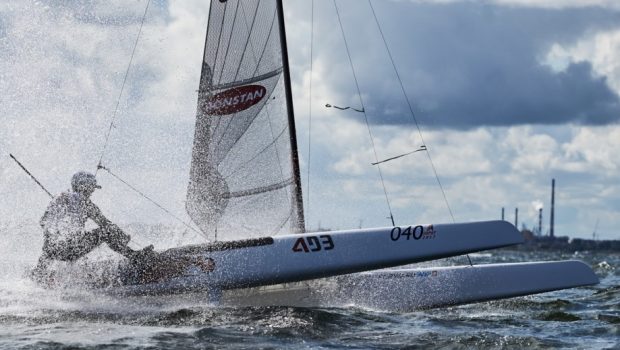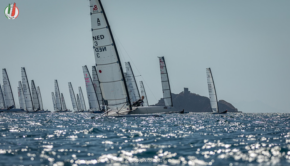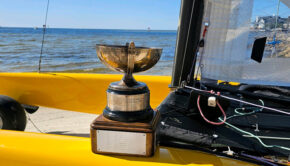Staying at the Cutting Edge, the “A” Class Cat
Published on August 27th, 2017
With the end of the ‘A’ Class Catamaran World Championships, seeing Stevie Brewin (AUS) crowned for his third title, now is a good time to reflect on what has been happening in the ‘Formula 1’ of small sailing cats over the last couple of years. The development class, conceived in late 1950’s, is never standing still.
Back in 2015, at Hellevoesluis, Mischa Heemskerk (NED) arrived with a revamp of an earlier sail shape he’d developed a few years earlier. The Decksweeper sail was designed to give the power lower down on the sail and thus keep the boat flatter. But, for displacement boats, the sail needed to give the boat some heel when going downwind, doing the ‘wild thing’ and flying a hull, reducing the drag for the best speeds.
He dropped the design back then, as no discernable benefit was observed. However, as a result of America’s Cup designs filtering back down to the ‘A’ Cat, and the advent of the foiling daggerboards, with their winged rudder systems, the need to keep the boats flatter became much more important. So, in the May he turned up at the Dutch Nationals and wiped the floor with the fleet. Beaten by some margin that weekend was one Glenn Ashby (AUS).
Fast forward to the September and to Punta Ala for the Worlds. Both sailing for the DNA factory team, Ashby had gone home, simply chopped a chunk off the top of an older sail and stitched on the same area at the bottom to create a decksweeper. In the ensuing regatta, he beat Mischa in every race, and by an increased margin each time. The decksweeper was here to stay for foiling boats.
The debate then started as to the foil design and to which shape was the best for whatever. This was made much more interesting by the famous ‘A’ class rule 8, which stated that, all foils must be inserted from the top of the hull. The tips underneath to be no closer than 1.5m apart, and at no time during insertion and operation was any part permitted to go outside the 2.3m maximum beam. Of course, the class was free to decide to abolish rule 8, but it was decided to keep it in the narrowest of votes at the World AGM in 2015.
Fears of all sorts of wild board shapes and the ‘law of unintended consequences’ where boats could just become twin hulled Moths or something were averted and the very clever people in the class set about doing stuff, but all within the rules. The current shape is the Z foil, with subtle variations in shape, profile and longitudinal placement being fine tuned. Rake systems are becoming simpler and adjustment easier, at least when compared to the early pioneer’s designs. A variant has since filtered through to the Nacra 17 now too.
In late 2015/early 2016, two of the leading manufacturers suddenly released new models to the surprise of the class. First was the Polish Exploder Ad3. Designed by Spanish sailor and designer Gonzalo Redondo, it was a new take on their earlier A13/14/15 designs, but with altered beam and mast foot positions, the foils were move further forward and the hull shape altered to incorporate more fore and aft rocker to allow lower foiling lift off speeds.
It was an immediate success commercially as it was noticeably easier to foil compared with the earlier designs that relied upon considerable circus skills to balance the boat and avoid that crowd-pleasing wipeout.
Then the Dutch firm, Holland Composites, unveiled their stunning looking DNA F1. The prototype was in a clearcoated black carbon finish. Huge attention had been paid to the aero package on the boat. The beams had streamlined fairings to smooth the airflow over the trampoline. The tramp itself was made from carbon cloth and was stiff with a taut fabric under tramp.
Everything was hidden inside this sandwich, all the lines, and control sheets within this. It was sealed to the hull, so no air would escape upwards and created a tunnel hull effect. Even the tiller bar joiner was aero designed to be in the lee of the rear beam. It looked like a rocket ship. And sailed like one too in the hands of it’s co-designer Misha Heemskerk. He was simply untouchable in the 2016 Worlds in DNA’s back garden at Medemblik. However, costing more than the average Mercedes C class, it was a rich boys play thing indeed.
Foil shape and rudder tip shapes are still being played with, but the latest developments look to be in rig design. The deck sweeper, with its lower centre of power has been fitted on mast cut down from the original 9m to about 8.3. This allows the bottom to get wider and further add power lower on the sail.
The new World Champ, Stevie Brewin, has been sailing in AUS with this rig setup very successfully.
However, he frequently sails in more breeze at his club and on the AUS circuit than many European and US sailors. He elected to use the full rig at Sopot for this very reason. Another school of thought is that this would just end up with a Laser sail in the end.
Tall, high aspect ratio may be the other way to go in the end, as we may not realize how efficient the ‘A’ cat rig actually is for it’s weight. Most use this sail with a curved carbon boom, however Stevie has developed a boomless variant that works just as well, if you know how to use it.
The ‘A’ cat fleet and World Sailing has now officially designated two boat types as variants within the same class of boat. The non-foiling, or Classic, as it is officially called, has many more sailors than the sexy young foilers now seen at the front in such regattas. However, the international class association, IACA, has been keen to bring them all back into the fold under it’s protective wing, rather than let them all wander away muttering under their breath.
They now have a separate official handicap in both the SCHRS and PY systems. Many older sailors greatly enjoy the racing in the Classic fleets. Circus skills and super bendy legs are less common amongst these experienced veterans, but they still want to come to the party.
Also, the Classic is the ideal starter boat for the class. By learning all the skills and tuning techniques that this technical boat demands, they provide the best foundation course available. Many National associations now run parallel rankings for both fleets, and the race on the same courses. But beware of them in the light stuff. Classics will often get a win, as the much higher drag of the foiler’s underwear is a considerable slowing problem.
Now things are settling down a bit as far as platform designs are concerned. The Swiss manufacturer of the Scheurer G7 has been developed by the SUI sailor Sandro Caviezel, who has designed an extended empennage, filling in the space between the rear beam and the hull stern. This is designed to smooth the airflow out from under the hull and reduce drag further. Seems to work too in the higher winds.
But at the 2017 Championship, there was no groundbreaking technological development that trumped the rest of the fleet. The sailors had caught up with decksweepers, Z foils etc., and it looks like it is back to good old fashioned sailing skill. The new techniques have been mastered by many of course, but the racing was far closer than it had been for the last two years.
This year, a few figures stood out in the fleet. Local Polish sailors Tymuk Bendyk, Kuba Surowiec and Maciej Zarnowski were all up with the pace. Tymuk particularly loved the heavy stuff and he has sailed in those waters since the age of seven. Kuba likewise was always on the pace. Maciej put in solidly good results, until his starboard bow was neatly severed in the first race of the windy Wednesday, rendering him out of contention despite getting redress for that race.
Mischa was always going to find it hard to retain his crown. His F18 World title has taken time away from his ‘A’ cat training, plus the lack of regular training partners didn’t help either. In the end, his campaign was probably over in race 2, when he capsized at the bottom mark whilst chasing Stevie, then fatally miscounted the laps, and put in another one.
Despite giving it everything, it cost him 29 places and the title. Darren Bundock (AUS) was on equal points with Stevie after the qualifiers, being in separate fleets and both led. But when they met in the medal races, the student beat the master. 5th was his final finishing position. Manuel Calavia (ESP) was awesomely fast. He showed great pace in the previous weeks Polish Nats by winning the event.
However an OCS on race 2 hurt him fatally as it turned out. 10th was his eventual position. Dave Shaw (NZL) was the surprise find of this regatta. His hard work and training paid off spectacularly, and he was in the running to be on the podium until the last day of racing. And in the Classics, Pontius Johnson (SWE) on his black Marstrom was 22nd overall in the 125+ fleet.
With something for everyone, Sopot didn’t disappoint. Monday was a lovely 12-14 kts. Tuesday was 8-10, so marginal foiling was had, but it increased nicely later in the day. Wednesday was a full-on 17-19 kt blast with 3ft waves to match, but by the afternoon’s first medal race, it had moderated somewhat. But it was the Thursday racing that put pay to several podium hopes.
On a light wind day, in the second race, most of the hotshots took the left of the course in a light and shifting wind. Those who were forced to tack off at the start, due to being in dirty air or bad positioning, found themselves on the right of the course and in a huge shift and increased pressure, giving them all the jump on all the superstars over on the left. The lead was almost 2 mins in many cases.
Bruce Mahoney (USA) made the most of his opportunity and led for most of the race, being overtaken by Stevie on the last leg, but with a virtuoso display of light airs foiling, Bruce pipped him to the bullet by a boat length. Only Stevie had managed to claw his way back to the front. All the other title challengers were left languishing in the thirty and fortysomethings.
Before the regatta, it was predicted that the best reader of the wind would emerge at the top. Brewin was that man. He was equally comfortable in both the heavy and the light stuff, master of all the techniques needed to clinch his third World title. He is a truly great sailor and deserved his win.
The next big international events are in 2018 in July at Warnemünde GER, then the Worlds in Hervey Bay AUS, November 2018, then to Weymouth UK in August 2019.
2017 A Cat Worlds Event Details – Results
Source: Gordon Upton, Editor, A-Cat.org









 We’ll keep your information safe.
We’ll keep your information safe.